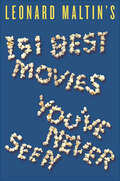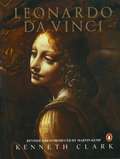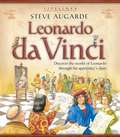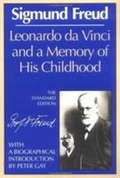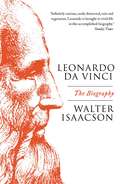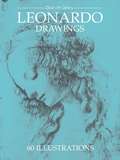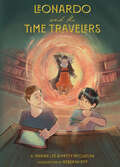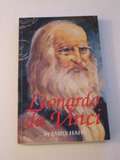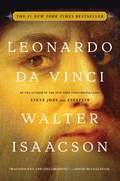- Table View
- List View
Leonard Maltin's 151 Best Movies You've Never Seen
by Leonard MaltinWhat 151 movies have you never seen—but should?What French film could teach Hollywood how to make a smart, sexy romantic comedy? (page 233)Where will you find a female-centric Western with a gender-bending protagonist? (page 10)What film won a Special Jury Prize at Sundance and then fell off the radar? (page 261)What farcical comedy includes such real-life characters as Richard Nixon and Henry Kissinger? (page 50)In what unsung comedy will you find Michael Douglas giving his all-time best performance? (page 130)What debut film from the director of The Dark Knight creates palpable chills—despite a shoestring budget and a no-name cast? (page 79)What John Wayne movie was out of circulation for thirty years—and still qualifies as a sleeper? (page 121)What terrific Heath Ledger movie was released the same month as Brokeback Mountain—and flopped? (page 26)What clever modern-day film noir was made for just half a million dollars? (page 18)What captivating film stars one of the seminal artists of the twentieth century? (page 203)
Leonardo
by Holly BianchiLeonardo, one of Monmouth County's most picturesque seaside resorts, is portrayed in images that will fill the heart and lift the spirit. With some two hundred vintage photographs, Leonardo offers an overview of this beautiful beach town, which lies on the banks of the Sandy Hook Bay in central New Jersey. A tightly knit and friendly community, Leonardo has long been recognized as a haven for artists and writers. The town's sandy beaches and intriguing maritime history attract thousands of visitors every year.With a collection of early-twentieth-century to the recent past photographs and informative historical information, Leonardo explores the many features of a town that has become known as the "jewel in the crown." This history features images of Leonardo's celebrated sculptor and artist Donald DeLue, who created the sculpture The Rocket Thrower for the 1964-1965 New York World's Fair. Also seen are photographs of the Leonardo State Marina and the famous Conover Beacon Lighthouse. The historic Applegate Cemetery, where the legendary Mary Stillwell Applegate is buried, is pictured along with a description of its folklore tale.
Leonardo Da Vinci
by Kenneth Clark Martin KempA personally compelling introduction to Leonardo's genius, a classic monograph of Leonardo's art and his development.
Leonardo Da Vinci
by Steve AugardeThis illustrated biography series combines non-fiction and fiction to introduce readers to famous historical characters. Each book begins with a diary, told from the point of view of a child who works for the famous person. At the end of each book there is an illustrated reference chapter.
Leonardo Da Vinci and a Memory of His Childhood
by Sigmund FreudA detailed reconstruction of Leonardo's emotional life from his earliest years, it represents Freud's first sustained venture into biography from a psychoanalytic perspective, and also his effort to trace one route that homosexual development can take.
Leonardo Da Vinci: Cong Fan Ren Dao Tian Cai De Chuang Zao Li Mi Ma = Leonardo Da Vinci
by Walter Isaacson'To read this magnificent biography of Leonardo da Vinci is to take a tour through the life and works of one of the most extraordinary human beings of all time in the company of the most engaging, informed, and insightful guide imaginable. Walter Isaacson is at once a true scholar and a spellbinding writer. And what a wealth of lessons there are to be learned in these pages.' David McCullough Based on thousands of pages from Leonardo&’s astonishing notebooks and new discoveries about his life and work, Walter Isaacson weaves a narrative that connects his art to his science. He shows how Leonardo&’s genius was based on skills we can improve in ourselves, such as passionate curiosity, careful observation, and an imagination so playful that it flirted with fantasy. He produced the two most famous paintings in history, The Last Supper and the Mona Lisa. But in his own mind, he was just as much a man of science and technology. With a passion that sometimes became obsessive, he pursued innovative studies of anatomy, fossils, birds, the heart, flying machines, botany, geology, and weaponry. His ability to stand at the crossroads of the humanities and the sciences, made iconic by his drawing of Vitruvian Man, made him history&’s most creative genius. His creativity, like that of other great innovators, came from having wide-ranging passions. He peeled flesh off the faces of cadavers, drew the muscles that move the lips, and then painted history&’s most memorable smile. He explored the math of optics, showed how light rays strike the cornea, and produced illusions of changing perspectives in The Last Supper. Isaacson also describes how Leonardo&’s lifelong enthusiasm for staging theatrical productions informed his paintings and inventions. Leonardo&’s delight at combining diverse passions remains the ultimate recipe for creativity. So, too, does his ease at being a bit of a misfit: illegitimate, gay, vegetarian, left-handed, easily distracted, and at times heretical. His life should remind us of the importance of instilling, both in ourselves and our children, not just received knowledge but a willingness to question it—to be imaginative and, like talented misfits and rebels in any era, to think different.
Leonardo Drawings: Sketches & Drawings (Dover Fine Art, History of Art)
by Leonardo Da VinciAlthough Leonardo da Vinci was one of the greatest artists who ever lived, his career was marked by an unusually large number of uncompleted projects and by finished works that rapidly deteriorated. Nevertheless, his influence is undoubted, and his claim to greatness rests chiefly on his drawings, which have been carefully preserved in such locations as Windsor Castle, the Louvre, the Uffizi Gallery, and the British Museum.This collection, excellently reproduced in black-and-white, is representative of Leonardo's various achievements in many drawing media. Among the selections are drawings of plants, landscapes, animals, battles, weapons, and the human face and figure, as well as studies for later paintings or sculpture: a full compositional study for The Adoration of the Magi, a study for the angel's head in The Virgin of the Rocks, studies of horses for the Sforza monument, studies for The Last Supper, studies for The Battle of Anghiari, and an early cartoon for The Madonna with St. Anne.
Leonardo and the Last Supper
by Ross KingLeonardo da Vinci's transcendent painting The Last Supper defined the master artist. Until now, no one has told the full story behind its creation. Political events weighed on da Vinci and all of Italy during the time of the painting's conception and creation, as his patron, the Duke of Sforza, unleashed forces leading to a decades-long series of tragedies known as the Italian Wars. Sforza was overthrown by French forces in 1499, forcing da Vinci to flee Milan with the paint on The Last Supper barely dry. The Last Supper ensured Leonardo's universal renown as a visionary master of the arts.
Leonardo and the Time Travelers
by Marian Lye, Patty McGuigan, Illustrated by Rebekah ReifWHAT WOULD YOU DO... if a time traveler landed on your doorstep? In Leonardo and the Time Travelers, Jack and Nick are in Silicon Valley for a summer technology class, when they discover a secret time travel app. They bring back the world's first time traveler, Leonardo da Vinci, and adventure ensues! Joined by Jack's sister Poppy, they solve problems, meet other time travelers, and have a summer they will never forget.
Leonardo da Vinci
by Emily HahnLeonardo's interests and achievements spread far beyond the world of art. He studied astronomy, botany, anatomy, and geology, and designed and drew plans for hundreds of inventions, many of which fore-shadowed the achievements of men who lived four hundred years after Leonardo died. Emily Hahn brings this quintessential Renaissance Man to life in her delightful and easy to read biography.
Leonardo da Vinci
by Kathleen KrullLeonardo da Vinci's notebooks are mind-boggling evidence of a fifteenth-century scientific genius standing at the edge of the modern world, basing his ideas on observation and experimentation. This book will change children's ideas of who Leonardo was and what it means to be a scientist. .
Leonardo da Vinci
by Walter Isaacson<P>He was history’s most creative genius. What secrets can he teach us? The author of the acclaimed bestsellers Steve Jobs, Einstein, and Benjamin Franklin brings Leonardo da Vinci to life in this exciting new biography. <P>Based on thousands of pages from Leonardo’s astonishing notebooks and new discoveries about his life and work, Walter Isaacson weaves a narrative that connects his art to his science. He shows how Leonardo’s genius was based on skills we can improve in ourselves, such as passionate curiosity, careful observation, and an imagination so playful that it flirted with fantasy. He produced the two most famous paintings in history, The Last Supper and the Mona Lisa. But in his own mind, he was just as much a man of science and technology. <P>With a passion that sometimes became obsessive, he pursued innovative studies of anatomy, fossils, birds, the heart, flying machines, botany, geology, and weaponry. His ability to stand at the crossroads of the humanities and the sciences, made iconic by his drawing of Vitruvian Man, made him history’s most creative genius. His creativity, like that of other great innovators, came from having wide-ranging passions. He peeled flesh off the faces of cadavers, drew the muscles that move the lips, and then painted history’s most memorable smile. He explored the math of optics, showed how light rays strike the cornea, and produced illusions of changing perspectives in The Last Supper. <P>Isaacson also describes how Leonardo’s lifelong enthusiasm for staging theatrical productions informed his paintings and inventions. Leonardo’s delight at combining diverse passions remains the ultimate recipe for creativity. So, too, does his ease at being a bit of a misfit: illegitimate, gay, vegetarian, left-handed, easily distracted, and at times heretical. His life should remind us of the importance of instilling, both in ourselves and our children, not just received knowledge but a willingness to question it—to be imaginative and, like talented misfits and rebels in any era, to think different. <P><b>A New York Times Bestseller</b>
Leonardo da Vinci #9
by Ann Hood Denis ZilberTravel back in time to Renaissance Italy with the Robbins twins! In book nine of The Treasure Chest, Maisie and Felix continue to learn the magic of Elm Medona and the Pickworth family history. In the latest adventure, the twins travel to fifteenth- century Italy and meet a young Leonardo da Vinci. Every Treasure Chest book features a biography of the featured historical figure along with Ann's Favorite Facts from her research!
Leonardo da Vinci. 500 años (edición estuche con: Matar a Leonardo da Vinci | Leonardo da Vinci -cara a cara-)
by Christian GálvezEl estuche Leonardo da Vinci 500 años reúne las dos exitosas obras del experto en el polímata renacentista Christian Gálvez: Matar a Leonardo da Vinci y Leonardo da Vinci -cara a cara-. Matar a Leonardo da Vinci es la primera de las «Crónicas del Renacimiento» de Christian Gálvez, un thriller histórico en el que se dan cita arte, venganza y pasión. «Meser Leonardo da Vinci tiene un concepto tan herético que no se atiene a ninguna religión y estima más ser filósofo que cristiano. Por lo tanto, la resolución es firme y clara: debemos matar a Leonardo da Vinci». Europa, siglo XVI. Mientras España, Francia e Inglaterra ultiman su unificación, los Estados italianos se ven envueltos en conflictos permanentes por culpa de la religión, el poder y el ansia de expansión territorial. Lo único que les une es el renacimiento cultural de las artes. En la Florencia de los Médici, epicentro de este despliegue artístico, una mano anónima acusa de sodomía a un joven y prometedor Leonardo da Vinci. Durante dos meses será interrogado y torturado hasta que la falta de pruebas lo ponga en libertad. Con la reputación dañada, Leonardo partirá hacia nuevos horizontes para demostrar su talento y apaciguar las secuelas psicológicas provocadas en prisión. ¿Quién lo acusó? ¿Con qué motivo? Mientras se debate entre evasión o venganza Leonardo descubrirá que no todo es lo que parece cuando se trata de alcanzar el éxito. ------- Leonardo da Vinci -cara cara- es un fascinante análisis ilustrado de todas las teorías existentes sobre la imagen de Leonardo da Vinci. «Muchos de los manuscritos sobre anatomía humanaestán en posesión de Francesco Melzi, ungentilhombre de Milán que era un hombre bello en el tiempo en que Leonardo vivía y al que le profesaba un gran cariño.Francesco aprecia y conserva estos trabajos como reliquias de Leonardo, junto con el retrato de este artista en su feliz recuerdo.» Con estas palabras Giorgio Vasari, uno de los primeros historiadores de arte y autor de las biografías de los artistas italianos durante el Renacimiento, asegura que existe un retrato de Leonardo da Vinci que Francesco Melzi, alumno, secretario y albacea del artista florentino, guardó al morir el maestro. Por lo tanto tenemos una referencia histórica real de dicha imagen. ¿A qué retrato se refería Vasari? ¿Al supuesto autorretrato que guarda la Biblioteca Real de Turín y que mundialmente se reconoce como tal?, ¿o por el contrario al retrato que realizó Francesco Melzi mientras su maestro seguía con vida? ¿Son compatibles ambos retratos? ¿Coinciden esos rostros con el resto del imaginario de Leonardo da Vinci, tales como el de El hombre de Vitruvio de Venecia o los de La última cenade Milán? ¿Quién es el hombre representado en la Tavola Lucana? A través de estas páginas, prologadas por el prestigioso historiador Ross King, analizaremos todas las teorías que eruditos, historiadores y expertos en arte han elaborado en torno a la imagen del maestro florentino con un único objetivo: encontrar el verdadero rostro del polímata más conocido de la historia de la humanidad: Leonardo da Vinci. Christian Gálvez ha sido galardonado con el Premio de Periodismo Científico Concha García Campoy, por el exhaustivo trabajo de investigación y divulgación sobre la imagen de Leonardo da Vinci en el ensayo Leonardo Da Vinci- Cara a Cara cuyas conclusiones le han llevado a participar como experto mundial en el proyecto internacional Leonardo. DNA, que reúne a genetistas, historiadores, forenses, arqueólogos y otros expertos para desvelar los últimos misterios de la vida de Leonardo a través de su ADN en el año de su V centenar
Leonardo da Vinci: An Account of His Development as an Artist [Revised Edition]
by Sir Kenneth M. ClarkSir Kenneth Clark made his name as a scholar of Leonardo da Vinci by a Critical Catalogue of Leonardo’s drawings at Windsor Castle, published in 1935, which was recognized as establishing the subject on a firmer chronological basis. Four years later he produced this short book on Leonardo as an artist, which has been generally regarded as the clearest and sanest introduction to this great and controversial subject.This is the first book on Leonardo written after critics had reached general agreement as to which works were really by his own hand. It is also the first study of Leonardo to take advantage of our wider range of aesthetic experience and our fuller knowledge of psychology. Sir Kenneth writes ‘that all great art should be reinterpreted for each generation’, but although his interpretation of Leonardo is twenty years old, it remains valid today. He has written a fresh introduction which goes rather deeper than his previous conclusions, and for this edition has made extensive revisions to the text.“Your true critic must be doubly armed, with knowledge and intuition. Sir Kenneth Clark, armed with both to a remarkable degree, has written a book on Leonardo’s development as an artist which (I do not exaggerate) will set a new standard in art criticism in England.”—Sunday Times“It is so intelligent, so modest, so beautifully written and so wise.”—Harold Nicolson
Leonardo da Vinci: An Untraceable Life
by Stephen J. CampbellHow our image of the Renaissance&’s most famous artist is a modern mythLeonardo da Vinci (1452–1519) never signed a painting, and none of his supposed self-portraits can be securely ascribed to his hand. He revealed next to nothing about his life in his extensive writings, yet countless pages have been written about him that assign him an identity: genius, entrepreneur, celebrity artist, outsider. Addressing the ethical stakes involved in studying past lives, Stephen J. Campbell shows how this invented Leonardo has invited speculation from figures ranging from art dealers and curators to scholars, scientists, and biographers, many of whom have filled in the gaps of what can be known of Leonardo&’s life with claims to decode secrets, reveal mysteries of a vanished past, or discover lost masterpieces of spectacular value.In this original and provocative book, Campbell examines the strangeness of Leonardo&’s words and works, and the distinctive premodern world of artisans and thinkers from which he emerged. Far from being a solitary genius living ahead of his time, Leonardo inhabited a vibrant network of artistic, technological, and literary exchange. By investigating the politics and cultural tensions of the era as well as the most recent scholarship on Leonardo&’s contemporaries, workshop, and writings, Campbell places Leonardo back into the milieu that shaped him and was shaped by him. He shows that it is in the gaps and contradictions of what we know of Leonardo&’s life that a less familiar and far more historically significant figure appears.
Leonardo da Vinci: Renaissance Painter
by Brendan JanuaryKnown for his art, inventions, and ideas, Leonardo da Vinci is the definition of a "Renaissance Man," someone able to succeed in many different areas. Da Vinci's Mona Lisa and The Last Supper are two of the most famous paintings in history. His sketches of inventions and the human body have stayed in the minds of people for hundreds of years. Da Vinci's work and ideas have lived on long after he died, inspiring creative people in the modern world to reach new heights. Learn the story of one of the most important artists of all time in Leonardo da Vinci: Renaissance Painter.
Leonardo on the Human Body
by Leonardo Da VinciHere are clear reproductions of over 1,200 anatomical drawings by one of humanity's greatest geniuses -- still considered, nearly five centuries later, the finest ever rendered. With 215 plates, including studies of the osteological, myological, nervous, respiratory, alimentary, and genito-urinary system, this treasury will be admired by artists and scientists alike.
Leonardo to the Internet: Technology and Culture from the Renaissance to the Present
by Thomas J. MisaThe image of the lone inventor transforming society from the outside has a strong hold on the public's imagination. In reality, though, technologies are products of ongoing social and cultural processes.
Leonardo to the Internet: Technology and Culture from the Renaissance to the Present (Johns Hopkins Studies in the History of Technology)
by Thomas J. MisaHistorian Thomas J. Misa’s sweeping history of the relationship between technology and society over the past 500 years reveals how technological innovations have shaped—and have been shaped by—the cultures in which they arose. Spanning the preindustrial past, the age of scientific, political, and industrial revolutions, as well as the more recent eras of imperialism, modernism, and global security, this compelling work evaluates what Misa calls "the question of technology."Misa brings his acclaimed text up to date by examining how today's unsustainable energy systems, insecure information networks, and vulnerable global shipping have helped foster geopolitical risks and instability. A masterful analysis of how technology and culture have influenced each other over five centuries, Leonardo to the Internet frames a history that illuminates modern-day problems and prospects faced by our technology-dependent world
Leonardo to the Internet: Technology and Culture from the Renaissance to the Present (Johns Hopkins Studies in the History of Technology)
by Thomas J. MisaNow updated — A comprehensive, 500-year history of technology in society.Historian Thomas J. Misa's sweeping history of the relationship between technology and society over the past 500 years reveals how technological innovations have shaped—and have been shaped by—the cultures in which they arose. Spanning the preindustrial past, the age of scientific, political, and industrial revolutions, as well as the more recent eras of imperialism, modernism, and global security, this compelling work evaluates what Misa calls "the question of technology."In this edition, Misa brings his acclaimed text up to date by drawing on current scholarship while retaining sharply drawn portraits of individual people, artifacts, and systems. Each chapter has been honed to relate to contemporary concerns. Globalization, Misa argues, looks differently considering today's virulent nationalism, cultural chauvinism, and trade wars. A new chapter focuses on the digital age from 1990 to 2016. The book also examines how today's unsustainable energy systems, insecure information networks, and vulnerable global shipping have helped foster geopolitical risks and instability and takes a look at the coronavirus pandemic from the perspective of Wuhan, China's high-tech district. A masterful analysis of how technology and culture have influenced each other over five centuries, Leonardo to the Internet frames a history that illuminates modern-day problems and prospects faced by our technology-dependent world.
Leonardo's Brain: Understanding Da Vinci's Creative Genius
by Leonard ShlainBest-selling author Leonard Shlain explores the life, art, and mind of Leonardo da Vinci, seeking to explain his singularity by looking at his achievements in art, science, psychology, and military strategy and then employing state of the art left-right brain scientific research to explain his universal genius. Shlain shows that no other person in human history has excelled in so many different areas as da Vinci and he peels back the layers to explore the how and the why.Shlain asserts that Leonardo&’s genius came from a unique creative ability that allowed him to understand and excel in a wide range of fields. From here Shlain jumps off and discusses the history of and current research on human creativity that involves different modes of thinking and neuroscience .The author also boldly speculates on whether or not the qualities of Leonardo&’s brain and his creativity presage the future evolution of the human species.Leonardo&’s Brain uses da Vinci as a starting point for an exploration of human creativity. With his lucid style, and his remarkable ability to discern connections in a wide range of fields, Shlain brings the reader into the world of history&’s greatest mind. .
Leonardo's Foot
by Carol Ann RinzlerA Selection of the Scientific American, History, and BOMC2 Book Clubs"An in-depth look at the anatomy and history of feet reveals their often overlooked importance in human evolution, medicine and art." -Science News"Stylish, informative, entertaining, and pleasantly personal . . . Whether Rinzler is exploring how our feet explain or illuminate such topics as evolution, disability, racism, diet, or desire, she maintains a fascinating perspective on the peculiarities of being human." -Rain Taxi Review of Books"This neat little book draws a clear picture of our feet, providing understanding that extends far beyond the obvious. Readers often like to walk away from a book feeling they learned something-that the author left them with a new way to look at an old idea, and this book fulfills that need." -City Book Review"Rinzler lifts the lowly human foot to new heights in this appealing book." -Booklist (starred review)Leonardo's Foot stretches back to the fossil record and forward to recent discoveries in evolutionary science to demonstrate that it was our feet rather than our brains that first distinguished us from other species within the animal kingdom. Taking inspiration from Leonardo da Vinci's statement that "the human foot is a masterpiece of engineering and a work of art," Carol Ann Rinzler leads us on a fascinating stroll through science, medicine, and culture to shed light on the role our feet have played in the evolution of civilization.Whether discussing the ideal human form in classical antiquity, the impressive depth of the arching soles on the figures in Sandro Botticelli's Birth of Venus, an array of foot maladies and how they have affected luminaries from Lord Byron to Benjamin Franklin, or delving into the history of foot fetishism, Rinzler has created a wonderfully diverse catalog of details on our lowest extremities. This is popular science writing at its most entertaining-page after page of fascinating facts, based around the playful notion that appreciating this often overlooked part of our body is essential to understanding what it is to be human.Carol Ann Rinzler, a former nutrition columnist for the New York Daily News, has contributed to a number of publications, including the New York Times. She is the author of more than twenty books on health and medicine, including Nutrition for Dummies, an international bestseller translated into fourteen languages.
Leonardo's Holy Child: A Connoiseur's Search for Lost Art in America
by Fred R. KlineA single sketch becomes an all-consuming quest to understand and identify a work by Leonardo da Vinci himself--the first new drawing by the great master to have surfaced in over a century. Fred Kline is a well-known art historian, dealer, connoisseur, and explorer who has made a career of scouring antique stores, estate sales, and auctions looking for unusual--and often misidentified--works of art. Many of the gems he has found are now in major museum collections like the Frick, the Getty, and the Metropolitan Museum of Art. But this book is about the discovery of one piece in particular: About ten years ago, when Kline was routinely combing through a Christie's catalog, a beautiful little drawing caught his eye. Attributed to Carracci, it came with a very low estimate, but Kline's every instinct told him that the attribution was wrong. He placed a bid and the low asking price and bought the drawing outright. And that was the beginning of how Kline discovered Leonardo da Vinci's model drawing for the Infant Jesus and the Infant St. John. It is the first work by da Vinci to have surfaced in over a century. Leonardo's Holy Child chronicles not only the story of this amazing discovery, from Kline's research all over the world to how exactly attributions work with regards to the old masters (most of their works are unsigned). Kline also sheds light on the idea of "connoisseurship," an often-overlooked facet of art history that's almost Holmesian in its intricacy and specificity.
Leonardo's Legacy: How Da Vinci Reimagined the World
by Stefan KleinRevered today as, perhaps, the greatest of Renaissance painters, Leonardo da Vinci was a scientist at heart. The artist who created theMona Lisaalso designed functioning robots and digital computers, constructed flying machines and built the first heart valve. His intuitive and ingenious approach-a new mode of thinking-linked highly diverse areas of inquiry in startling new ways and ushered in a new era. InLeonardo’s Legacy, award-winning science journalist Stefan Klein deciphers the forgotten legacy of this universal genius and persuasively demonstrates that today we have much to learn from Leonardo’s way of thinking. Klein sheds light on the mystery behind Leonardo’s paintings, takes us through the many facets of his fascination with water, and explains the true significance of his dream of flying. It is a unique glimpse into the complex and brilliant mind of this inventor, scientist, and pioneer of a new world view, with profound consequences for our times.
